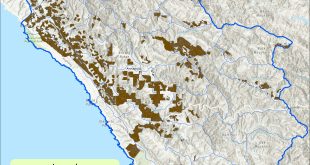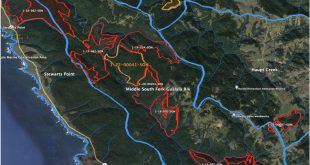| This article was published in the Independent Coast Observer on April 11, 2003. |
The second – and likely final – review of Timber Harvest Plan 1-00-484 SON on Haupt Creek south of Annapolis is set for April 24 at the California Department of Forestry’s Forest Practice Office in Santa Rosa. To help prepare the public for that review, where the plan could be approved, Friends of the Gualala River held a public meeting last Thursday evening at the Gualala Art Center.
Greg Giusti, UC Extension Forester, specializes in vertebrate habitat relationships in redwood forests. His talk put the Haupt Creek grove in context.
Coastal redwoods are a remnant species, Giusti said. “They literally are hanging on to the edge of the continent.” Their family has been around for 240 million years.
Loss of redwood forest causes loss of dependent species, some well known like the marbled murrelet which in the continental U. S. nests only on broad, mossy branches in old growth forests, others little known or undiscovered.
It is hard to find in scientific literature the structure of a redwood forest, so Giusti is working on that. His study area is Montgomery Woods east of Fort Bragg, where the tallest known redwood stands, the 364-foot Mendocino Tree.
Previous studies of redwood groves kept to the alluvial flats along creeks, so Giusti’s study plots go up a steep hill from a creek. It is a mixed forest. Small trees are all tanoak; large trees are all redwood. Some redwoods are so huge that high branches are really additional trunks. Under natural conditions, redwood trees replace themselves one tree at a time, or a few at a time, as individuals fall or groups go down with a landslide.
Fire played a role, both naturally and as used by the Indians. Giusti finds 100 percent of redwoods 32 inches in diameter or more have fire scars in his Montgomery Woods study.
He concludes that forestry is not as sensitive in retaining forest components as it might be; uneven-age management [not clearcutting] might work better.
Former Congressman Dan Hamburg introduced Kent Stromsmoe of Ancient Trees, on the web www.ancienttrees.org.
Stromsmoe is the author of the California Heritage Tree Initiative, which is now a Senate Bill 754 by Senator Don Perata (D-Oakland). SB 754 faces its first hearing on April 24 in the Senate Natural Resources and Wildlife Committee.
The bill seeks to save individual trees in private ownership that were standing before 1850. Seven million trees could be saved by SB 754. Hamburg called old growth logging “a practice that should go the way of whaling and other things we don’t do anymore.”
Stromsmoe said the bill seeks to save trees that were standing before the beginning of commercial logging in California, and preserve a sense of heritage from Indian, Spanish and Mexican times. This pointed to a date of 1850.
By retaining individual old growth trees, we may be able to retain the many associated species that could then spread to younger trees. “You can get back a natural forest structure much more quickly,” Stromsmoe said.
Dave Hope from the Water Board staff, who wrote the report for that agency on the Haupt Creek THP, was the last speaker. He said he comes at this issue from another angle, as a member of a timber family. “I basically grew up in a clearcut,” he said. “I actually know how long it took for that land to get back up on its knees.”
He learned in Santa Cruz that there is a way of thinning that causes large trees to grow. Ideally, foresters who know how to do this will teach others their methods. Not to maximize continued yield in a redwood forest “is the height of foolishness,” Hope said.
Hope said forests with old growth trees in them look different; the younger trees get old growth characteristics sooner, like broad side branches. The Haupt Creek grove, off Tin Barn Road south of Skaggs Springs Road, is not on an alluvial flat, but is an unusual upland redwood and fir forest. His slides showed it looming like a wall over a 50-year-old, healthy second-growth stand.
There is more than 800 acres of old growth associated with other undisturbed land for a total complex of about 2,000 acres. Some trees are six to eight feet in diameter.
THP 484 would cut only 55 acres, but these are along Haupt Creek on steep slopes. When adjacent land downstream was cut over, it failed in landslides. The Richardsons, who own the land, should be compensated for not cutting it, Hope said. He found a buyer, but the owners were not willing to sell. They could sell just the timber rights and keep the land closed to the public.
During the question period that followed there was a debate between people who want to see the forest cut and those who want it saved.
| For more information, see: Haupt Creek summary page |
 Friends of Gualala River Protecting the Gualala River watershed and the species living within it
Friends of Gualala River Protecting the Gualala River watershed and the species living within it


